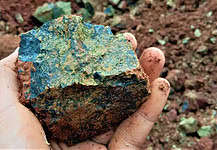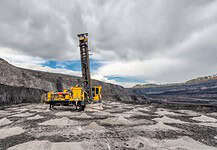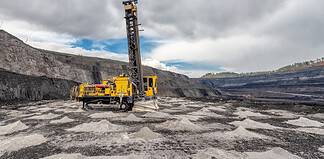There’s a lot to like about where Australia’s ‘critical minerals’ industry is headed, with many mines already in development to capitalise on the growing battery and EV markets. However, there are still knowledge gaps when it comes to mineral processing and manufacturing that require further investigation. Elizabeth Fabri spoke with Geoscience Australia Resources Division chief Andrew Heap about opportunities for Australia on the back of the agency’s recently released reports.
Q. Tell us about your background in geoscience and some career highlights to date?
I am currently chief of the Resources Division at Geoscience Australia with responsibility for energy and mineral, carbon capture and storage, and marine geoscience programs: a position I have held since September 2017.
I am a sedimentologist and geomorphologist by training, with additional qualifications in international business, having completed Bachelor of Science and Commerce and Master of Science degrees at the University of Auckland, followed by a PhD at James Cook University in Townsville. I joined Geoscience Australia in 2000 and have had responsibility for leading its Energy and Marine and Coastal geoscience programs, prior to my current role.
Apart from the honour of now leading Geoscience Australia’s programs to support Australia’s resources sector, some career highlights include:
- Design of Geoscience Australia’s current Exploring for the Future program, which is helping explorers target new mineralisation by imaging the deepest roots of mineral systems all the way through to the surface, and is employing many world-first techniques;
- Completion of a detailed assessment of Australia’s geological carbon dioxide storage potential in highly prospective sedimentary basins;
- Establishment of the National Offshore Petroleum Information System to streamline industry access to Australian Government holdings of offshore petroleum exploration data; and
- Embedding geoscience as a criterion for designing Australia’s system of marine protected areas.
Q. In March, Geoscience Australia released its Critical Minerals report, can you provide a brief run down on the main points people can take away from this?
The Critical Minerals in Australia report and previous reports by Geoscience Australia have identified the potential for Australia to produce a number of critical minerals either from existing mines, undeveloped prospects or new discoveries. This potential exists through much of the country but is poorly understood and requires further investigation. The report outlines a number of short, medium- and long-term activities to best position Australia in this sector. Australia has proven its ability to be an ethical and secure source of minerals, and therefore a smart and secure choice for investment.
Q. What are deemed the critical minerals in Australia at present and why?
To be classified as ‘critical’, a mineral must be both economically important to society and vulnerable to supply disruption. One of the focuses of the Critical Minerals in Australia report is Australia’s potential to become a major global supplier of minerals critical to 21st century technologies. In other words, minerals that aren’t just critical to Australia but also countries around the world.
For example, the ‘battery elements’, including cobalt, lithium, and graphite, are essential to the manufacture and development of renewable energy systems and for electric cars. Tellurium, gallium, indium, and rare-earth elements are key components of solar panels and wind turbines. Germanium is essential for electronic devices, especially screens.
Indium is a commodity with a currently small market size compared to that of many other critical minerals. Indium is commonly recovered during the processing of zinc concentrates produced from zinc-lead mines, particularly from granite-related and volcanic-hosted massive sulfide deposits. The main use of indium is in electronics, for example in the manufacture of TV monitors, as semi-conductors, in the manufacture of solar cells, and as a substitute for mercury in some uses.
Q. Many critical minerals are mined as by-products currently, is Australia well-placed to meet demand for these particular commodities?
Our leading expertise in mining and processing as well as extensive mineral resources that are likely to contain critical minerals positions us well to become a major and secure global supplier of critical minerals.
If we are to reach our full potential, however, more work needs to be done. Many critical minerals are produced as by-products of the mining and processing of major commodities. The Critical Minerals in Australia report indicates that there is an opportunity for Australian smelters and refineries to produce more critical mineral by-products. For example, a germanium and indium capability was recently added at the Risdon zinc refinery in Tasmania.
Processing is also a key issue when mining these materials – what further research and investigation is needed in this space?
The report indicates that there are a number of actions we can take to help Australia reach its full potential as a global supplier of critical minerals. These include further mineral processing technology development and enhancing our manufacturing capability.
Currently, there is insufficient knowledge of critical minerals in Australian deposits and their behaviour during metallurgical processing. More research is needed to understand the complete ‘life cycle’ of the critical minerals from their behaviour within ores through mineral processing and extraction to waste products. Once this information becomes available, the potential volumes of critical minerals recoverable from ores, concentrates, wastes, will be quantifiable.
Q. Geoscience also recently released its latest report on Australia’s Identified Mineral Resources (AIMR). What were the key findings here?
AIMR has been prepared annually by Geoscience Australia and its predecessors since 1975. This gives us more than 40 years of data to draw on to outline trends in reserve and resource estimates and mine production in both the long and short term. The latest edition of AIMR reaffirms Australia’s reputation as a world leading destination for investment in mineral resources. Worldwide, we are a top five producer of 17 minerals including gold, iron ore, lead, lithium and zinc.
In 2017, Australia’s mineral exports, excluding petroleum products, amounted to $179 billion – 59 per cent of all export merchandise and 46 per cent of all goods and services.
It is not just us saying this. The results of the well-respected Fraser’s Institute’s 2018 annual survey of mining and exploration companies found that Australia was the second most attractive region for mining investment in the world, behind Canada.
Western Australia was ranked the second most attractive jurisdiction in the world for mining investment. One of only two jurisdictions from outside of Canada and the United States to make the top ten.
The Australian Government is committed to ensuring Australia’s resources sector remains strong and successful. That is why it released in February this year Australia’s National Resources Statement, with the vision to position Australia’s resources sector as the world’s most advanced, innovative and successful.
Q. Final thoughts?
By almost any measure, Australia is a world-leader in mineral resources. However, as I look to the future and consider how a successful resources industry will continue to support our way of life, whether it be through our modern telecommunications and energy systems, advanced manufacturing, or electric vehicles, it’s important that we don’t rest on our laurels in this highly competitive and diverse global industry.
I see opportunity for all levels of government, industry and academia, to harness our collective capabilities and wisdom and work constructively together to maximise Australia’s potential from its vast mineral resources. I look forward to working will all of parts of the industry to ensure that resources remain part of Australia’s DNA.








































